OKR implementation – The complete guide for enterprises

"We would like to introduce OKRs." This sentence is now heard more and more frequently in corporate management. It can quickly become a challenge, even if the company already has a solid basic knowledge of the OKR method.
At Mooncamp, we have helped hundreds of companies across the globe successfully implement and scale OKRs.
That means we know what works and what doesn't.
Drawing from this experience and best practices, we've created “The complete OKR Rollout Guide – How to Scale OKRs to Thousands of Employees ”.
In this article, we provide some initial insights from the guide and share eight important steps for a successful OKR implementation.
What to expect:
- Getting started with OKRs
- Implementing OKRs – where to start
- 8 steps to a successful OKR implementation
- Rollout: Scaling OKRs within the company
- Conclusion: OKR implementation only works with thorough planning
- How to implement OKRs – FAQ
Getting started with OKRs
Before committing to implementing OKRs in the company, it's important to make sure everyone has understood the basics. Chances are, you've already read a few OKR books or watched some TED talks and the famous Google OKR video. So let's recap the most important things in a nutshell:
OKRs (short for “Objectives and Key Results”) are an agile framework for setting and achieving strategic goals within organizations, which – if used correctly – leads to more flexibility, transparency and success.
💡 Tip: If you want to recap all the OKR benefits, check out our blog for nine good reasons to start using OKRs today.
The OKR methodology itself is easy to understand. Writing good OKRs, however, is not so easy, because you have to find only the really important objectives out of many possible ones and put them down on paper.
- The Objectives describe what you want to achieve. They are formulated in a qualitative, simple and inspiring way.
- The Key Results define how you know that the goal is reached. They are quantitatively measurable, SMART, outcome-oriented, and time-bound.
- Initiatives are derived from the OKRs that determine how to reach the goal. They are formulated as concrete activities and can be directly influenced.
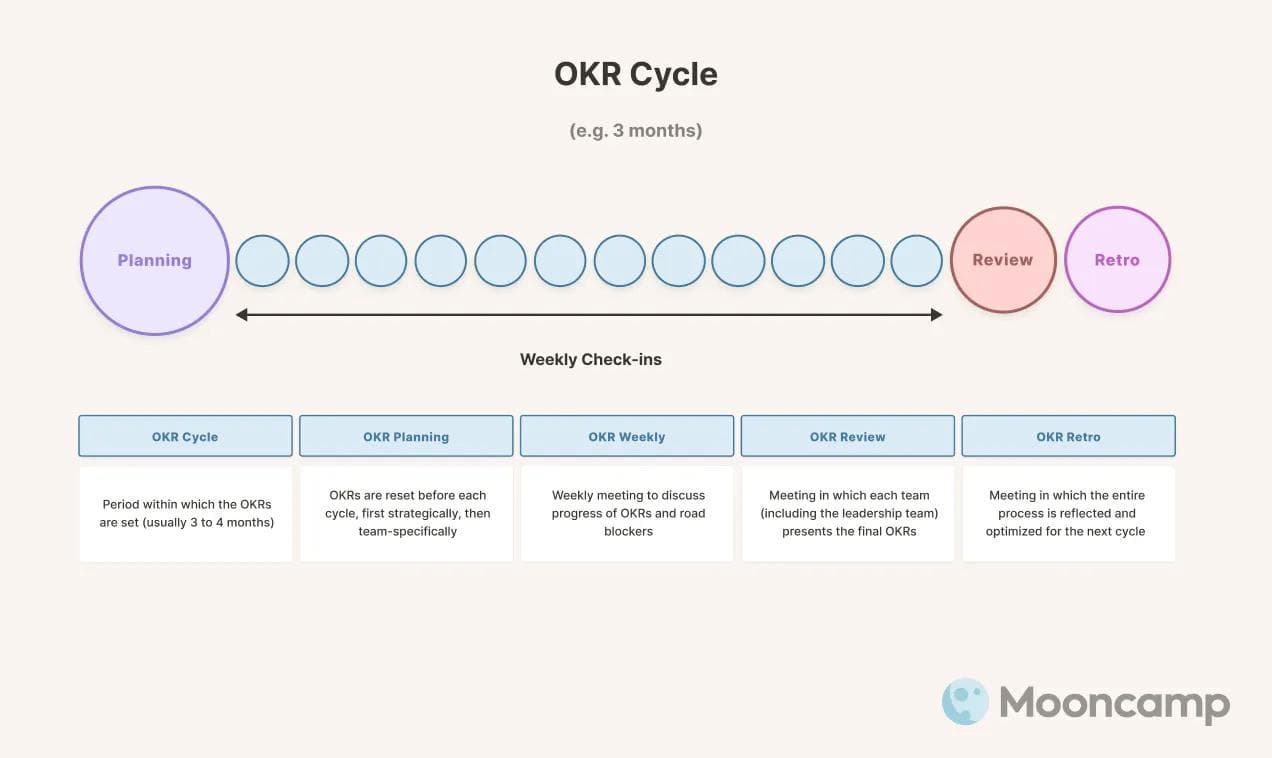
A distinctive feature of OKRs is that you create them both top-down and bottom-up. Typically, 40 percent of OKRs come from the management level. The focus here lies on strategic, company-wide goals. Teams then develop the remaining 60 percent.
💡 Tip: If you would like to refresh your basic knowledge of the OKR framework in more detail, it is best to take a look at our OKR Guide.
Implementing OKRs – where to start
OKRs only work properly if the conditions in the company are suitable. Therefore, before starting to introduce OKRs, it is worth taking a thorough look at the status quo.
The following requirements should be met:
- Openness and transparency: All employees and managers should see complete transparency as something positive and be open to the new way of working as well as ready for change.
- Vision and mission: There should be a meaningful vision and mission statement for the company that provides a clear strategic direction.
- Corporate culture: An open, appreciative culture should prevail in the company, in which mistakes are seen as an opportunity to learn.
- Distinction from employee appraisal: OKRs are not meant to judge, but to motivate to work more efficiently and accomplish more.
- Proper leadership: OKRs require a leadership style that emphasizes coaching and personal responsibility instead of instruction and control.
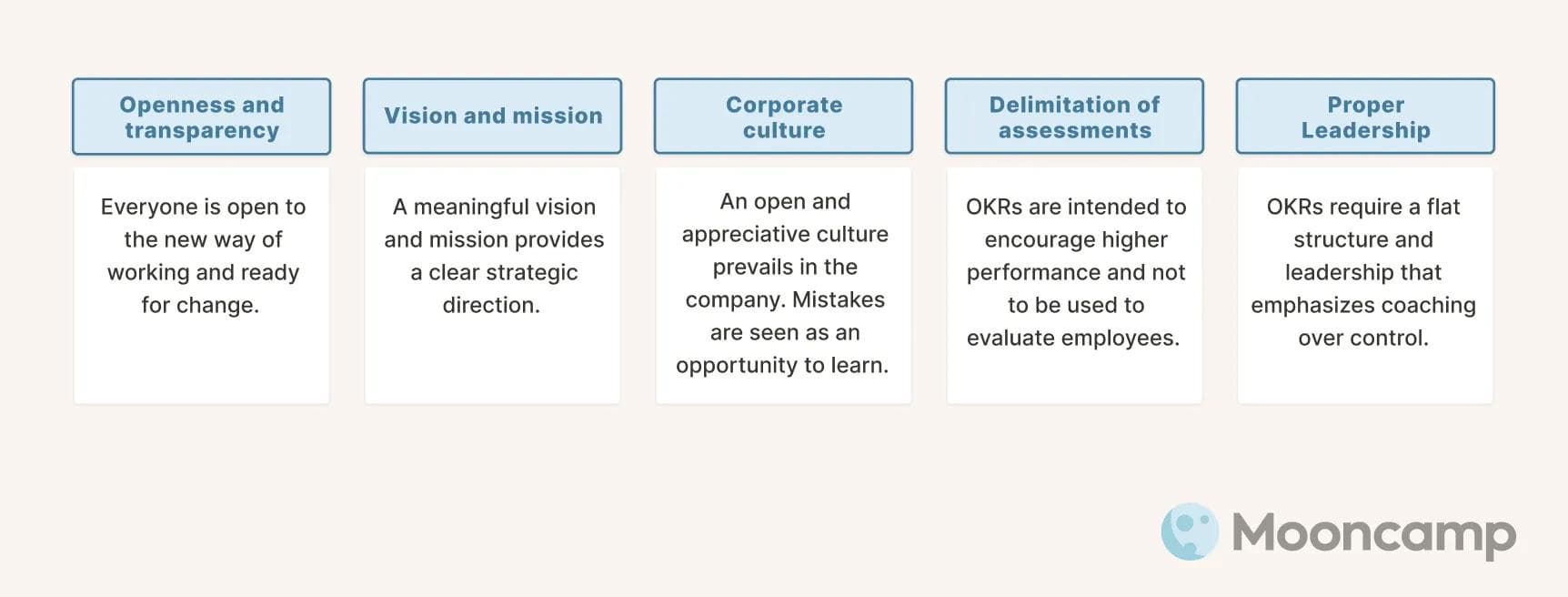
8 steps to successful OKR implementation
The basics are clear and all requirements are met? Then it's time for planning the implementation. Introducing OKRs in organizations with several hundred or even thousand employees requires a strategy and a clear approach. Our experience at Mooncamp shows that a successful OKR implementation usually takes place in eight steps.
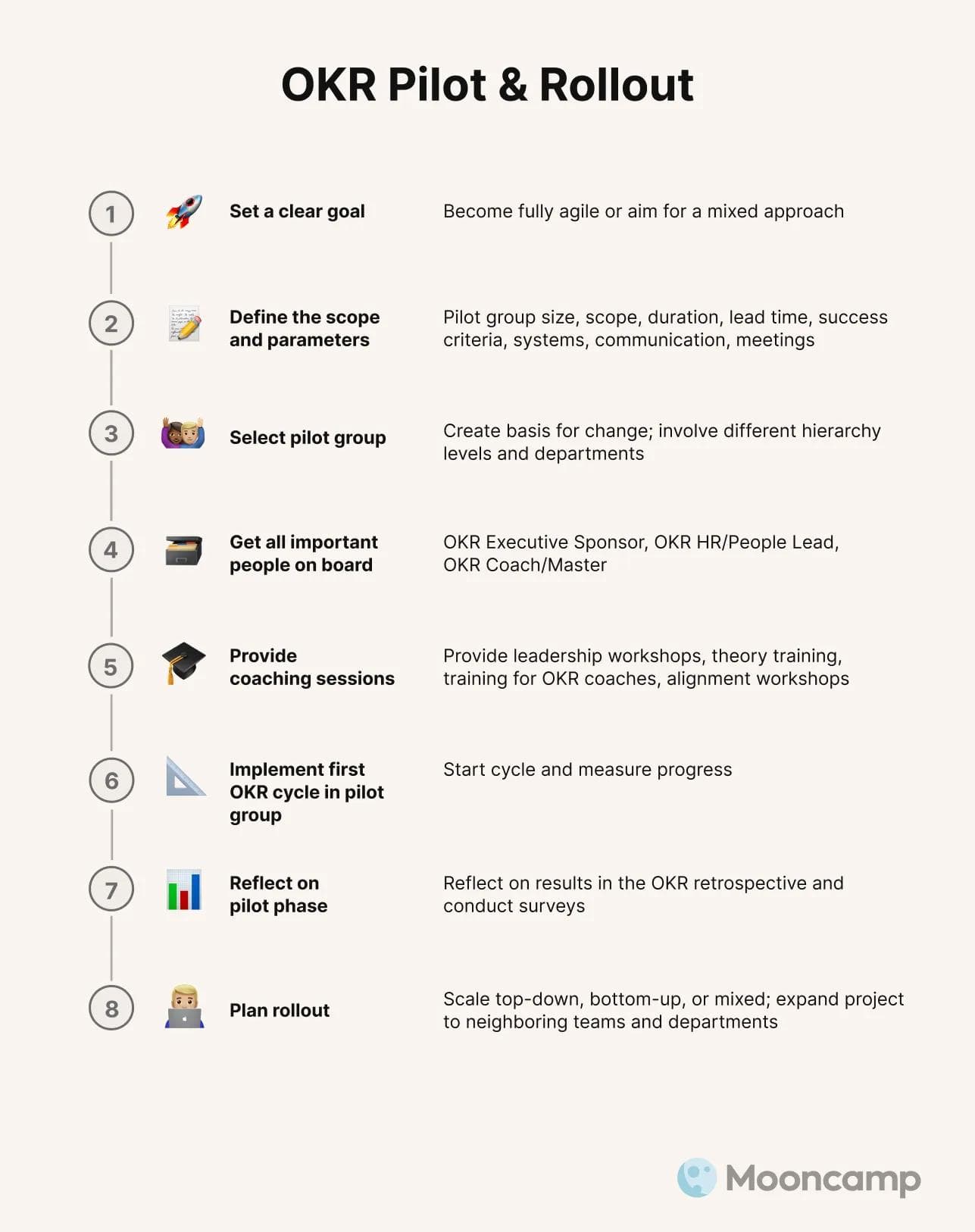
1. Set a clear goal
Before the implementation process is planned in concrete terms, it should be clear what goal is being pursued with the transformation. This does not always have to be a complete OKR rollout throughout the organization.
In fact, two approaches are possible: becoming fully agile or going for a mixed approach. An organization that is strongly market-oriented and repeatedly confronted with rapid changes in the environment can benefit greatly from full agility. If there are divisions within the organization that can be managed more predictably, it may be wise not to work with OKRs throughout the whole organization.
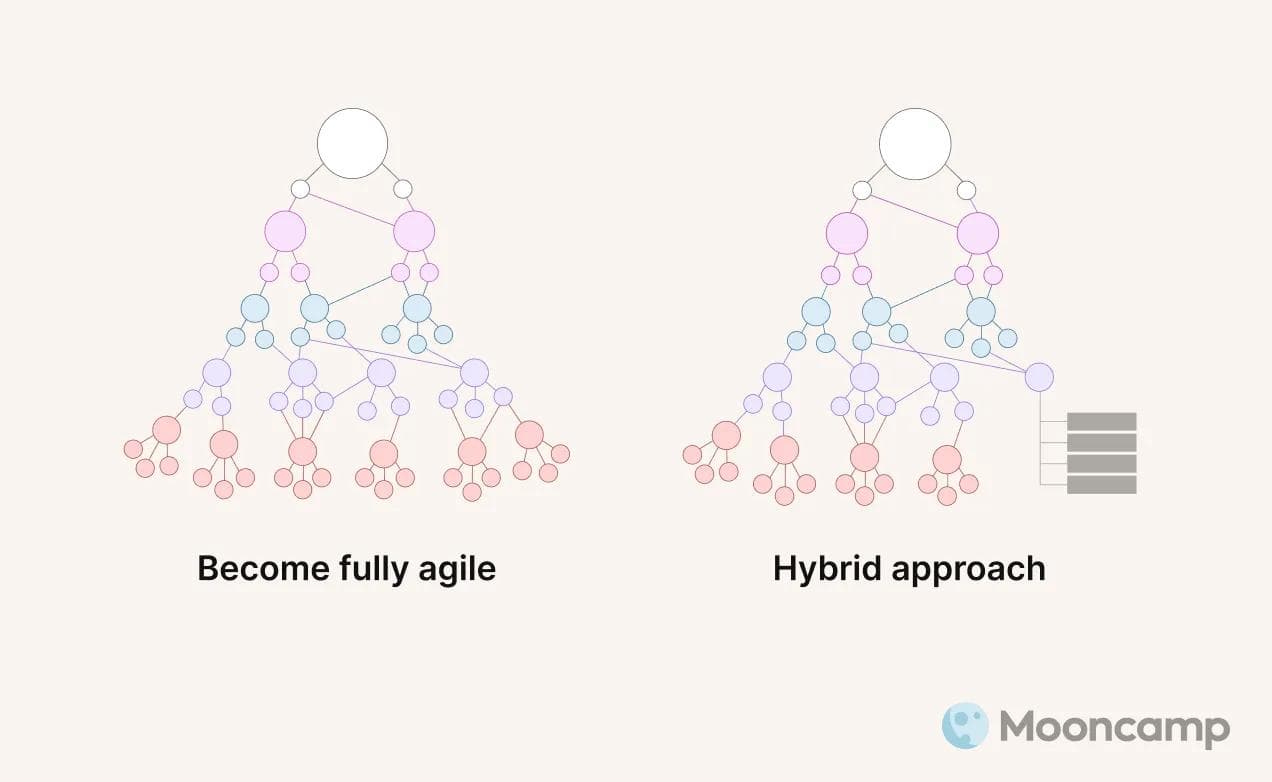
2. Define the scope and parameters
Once the company's goals for the transformation are established, the next step is to define the scope for the step-by-step implementation. In this context, the following points are important:
- Size of the pilot group
- Area
- Duration
- Lead time
- Success criteria
- Systems
- Communication
- Meetings
We recommend starting with an area of the organization that has experience with agile methods or at least shows an affinity for them. Before the first active cycle begins, it should also be determined how to track and evaluate OKR success in the process (e.g., a traffic ligh system with "At risk", "Off track", "On track" or a scale from 0.0 to 1.0), where to manage OKRs centrally (e.g., in OKR software such as Mooncamp), and what the communication strategy should be.
💡 Tip: Our recommendations for all the points mentioned above are summarized in the OKR Rollout Guide – including a checklist to make sure nothing is forgotten.
3. Carefully select the pilot group
Once the benchmarks and parameters are determined, the next step is to find the right pilot group. In addition to the size, it is important to
- create a stable base for the agile transformation,
- select a pilot group in which OKRs can be easily integrated into existing planning and reporting processes, and
- involve employees and managers from different hierarchical levels and departments, if possible.
Finally, it is also useful to involve employees who have a general desire to contribute to the change in the company and thus become internal influencers.
💡 Tip: A rule of thumb for companies is to start with pilot groups of no more than 100 to 250 employees. Some of these will be highly engaged, others will just participate.
4. Get all important people involved early
An important part of planning is answering the following question early on: Who should be involved? It is important to have the support from the highest management level (OKR executive sponsor, e.g. the CEO) and from the HR department (OKR people lead). You should also have a manager (preferably from senior leadership) backing and leading the project (OKR project lead). Last but not least, you should know which employees and team leaders (OKR owner) are responsible for the OKR process.
So-called OKR coaches are also central when it comes to putting OKRs into practice in day-to-day work. They accompany the OKR program in the long term, moderate the process, advise on the methodology, contribute best practices, and involve all key stakeholders. Especially for the first OKR cycle, it can be useful to assign this role to external OKR experts in order to benefit from their knowledge and skills (more on this in step 5).
💡 Tip: Depending on the size of the company, it sometimes makes sense to have several OKR coaches. You can find out the maximum number of teams an OKR coach should oversee in our OKR Rollout Guide.
5. Support all participants with coaching
Working with OKRs requires specific knowledge. To ensure that everyone involved has this knowledge, it makes sense to support the process with training, workshops and coaching.
Make sure to offer tailored training conducted by (external) OKR experts depending on what role someone is taking on. The training should take place both in advance (e.g. leadership coaching, theoretical instruction, communication training) and during the first active OKR cycles.
💡 Tip: External OKR consultants can create a foundation in the initial training and coaching sessions and teach the fundamentals. Later, the knowledge can be passed on internally. Participants from the pilot project then become ambassadors or OKR champions.
6. Implement the first OKRs in the pilot project
Once all preparations have been made, the first OKR cycle can be put into practice in the pilot group. In other words, specific Objectives and measurable Key Results for the first cycle are drawn up and agreed upon in workshops. The cycle then starts, OKRs are implemented and progress is measured.
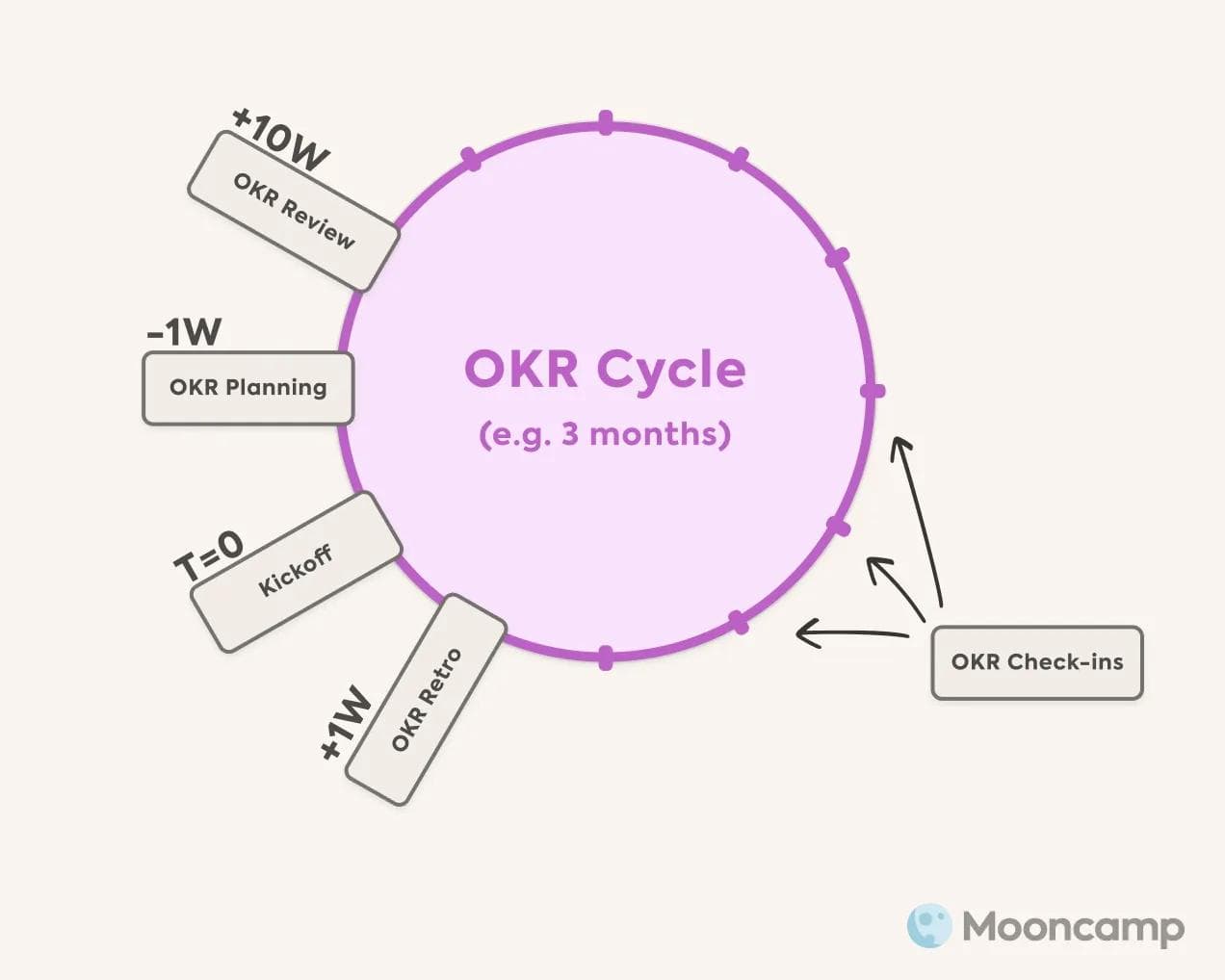
7. Reflect on the pilot phase and continuously ask for feedback
While the OKR Review reflects the content, i.e. the status of the OKRs, you should also take a look at the process or the OKR method itself and look for improvement potential in an OKR Retrospective. In general, this should happen whenever you work with OKRs, but it is especially important in the first cycles.
In this context, it is important that the meeting is well-prepared.
- The meeting should be announced well in advance. It is best to schedule it at the very beginning of the process and remind all participants at least two weeks beforehand.
- All participants should individually review the last OKR cycle and analyze the process before the meeting.
- The meeting should be conducted using a set agenda.
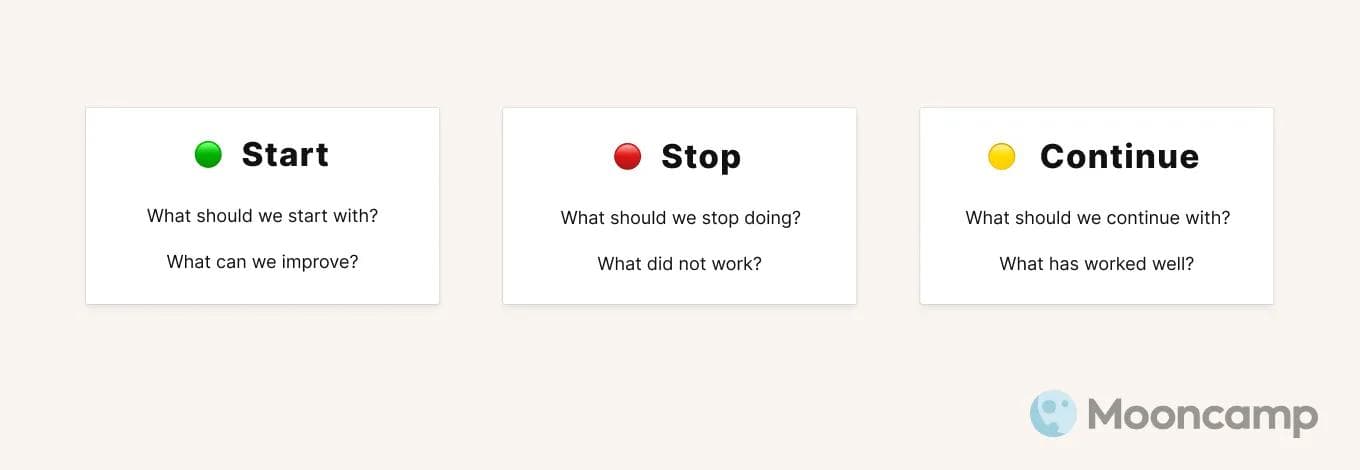
The goal of this step is to create an outstanding example of success that will inspire and motivate other groups – and form the basis for subsequent scaling.
8. Plan the rollout – let's scale! 🚀
It usually takes at least two cycles for the pilot to provide enough insights for the next step: roll out OKRs to additional teams and departments.
📝 Note: OKRs are a goal setting framework, not a fixed set of rules. It can take time to adapt all aspects of working with OKRs to the individual organizational context. In doing so, it is normal to struggle at first and find the initial cycles chaotic. Just keep at it, reflect on mistakes and see them as an opportunity to learn. True to Ben Lamortes motto “crawl, walk, run” – in other words, always take one step at a time: first crawl, then walk, then run.
What's next? Scaling OKRs within the company
When it comes to rolling out OKRs company-wide, one question arises: How are we going to scale? Depending on how the pilot group was selected, there are different approaches. Our OKR Rollout Guide explains the benefits and risks associated with each approach and exactly how they work.
Basically, a distinction is made between:
- Horizontal: along organizational structures (e.g., departments and functions) or along value streams.
- Vertical: bottom-up, top-down or in a mixed approach (Mixed Scaling)
Well, we can reveal this much already: Several hundred successful OKR implementations with Mooncamp worldwide have shown that Mixed Scaling is the most promising and at the same time most challenging approach. This approach involves introducing OKRs in an entire business unit, from the management level to implementation, and then scaling up from there.
💡 By the way: Our OKR Rollout Guide also contains six additional tips that help you think of everything when scaling and successfully introduce OKRs step by step throughout the entire company following the Mixed Scaling approach.
Conclusion: Introducing OKRs only works with thorough planning.
You can't switch to agile working with OKRs overnight. It takes time, money and resources – and a well-thought-out rollout with subsequent scaling. While every company is unique, there are nonetheless general insights and best practices that can help you get started.
Instead of “just going for it,” it pays to rely on the knowledge of experts and develop a clear plan. Our OKR Rollout Guide contains everything you need to implement and scale OKRs in large companies – from basic knowledge to different approaches and scaling options.
Plus: The challenge in introducing OKRs is not the methodology itself, but the fact that new ways of thinking and working need to be established for the framework to unfold its full effect. This requires a fundamental transition within the company and routines have to be disrupted.
Technology – especially an OKR software like Mooncamp – can support all steps and help to sustainably integrate the new processes and structures into the daily work routine. It visualizes goals and structures, is a central hub for communication and facilitates data-driven evaluation. It is therefore worthwhile to think about a suitable tool at an early stage. The important thing here is that the software should be adaptable to the needs of the company – not the other way around.
💡 By the way: With Mooncamp, every part of the OKR system can be adapted to individual needs, internal processes and own wordings – simple and user-friendly.
How to implement OKRs – FAQ
What is an OKR process?
The OKR process consists of five essential elements: OKR Cycle, OKR Planning, OKR Weekly, OKR Review, and OKR Retrospective. It maps everything that happens in terms of meetings and planning within a single strategy execution phase (typically one quarter).
How do you implement OKR successfully?
In order to implement OKR successfully, the following eight steps are important: 1️⃣ Set clear goal, 2️⃣ establish framework and parameters, 3️⃣ select pilot group, 4️⃣ get all key players on board, 5️⃣ provide coaching, 6️⃣ implement first OKR cycle in pilot group, 7️⃣ reflect on pilot phase, and 8️⃣ plan the rollout.
What is the purpose of implementing OKRs in the organization?
Implementing OKRs is associated with several benefits for companies: OKRs provide focus and alignment. They also promote autonomy, transparency and communication. Strategies are translated into measurable, easy-to-understand goals with OKRs, and companies can respond to change more easily and quickly.
How do you start implementing OKRs?
Implementing OKRs is best done step by step. The best way to start is by creating success stories in a pilot project and then expanding OKRs to other areas of the company. Before that, companies should also check whether all requirements have been met and create a strategy.

